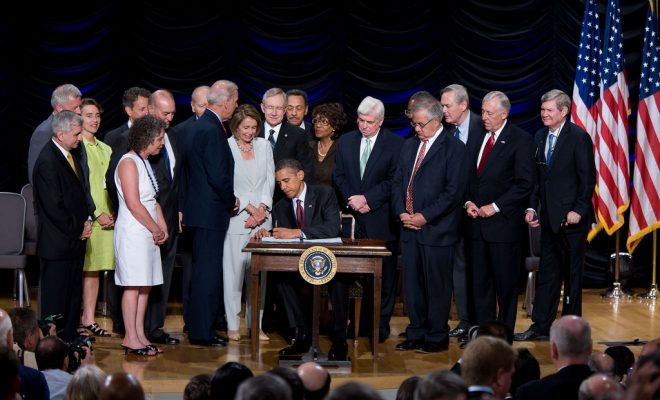 "President Obama Signs the Dodd-Frank Wall Street Reform and Consumer Protection Act" courtesy of Nancy Pelosi; License: (CC BY 2.0)
"President Obama Signs the Dodd-Frank Wall Street Reform and Consumer Protection Act" courtesy of Nancy Pelosi; License: (CC BY 2.0)
Business & Economics
What are the Most Important Components of the Dodd-Frank Act?
As President Trump and the Republican Congress continue their efforts to remove or weaken regulations put in place under the Obama Administration, changes to banking rules may be some of the most consequential. To understand what’s in store for American banking regulations, it’s important to look at their foundation, namely the Dodd-Frank Act that was passed in the wake of the 2008 financial crisis. Much of the current debate over financial regulation stems from the many provisions in Dodd-Frank. Read on for an overview of three of the law’s most important components and a look at its future.
The Dodd-Frank Act
In the wake of the 2008 financial crisis, Congress passed a law that sought to place additional regulations on banks, improve and unify oversight, and protect consumers in order to prevent another crisis from happening. While the actual success of that law–the Dodd-Frank Wall Street Reform and Consumer Protection Act, known as the Dodd-Frank–continues to be debated to this day, it is responsible for establishing many of the key components of the current regulatory system. The law created many new regulatory bodies that have churned out an even greater number of regulations, but for the purpose of this look, we will focus on three of the main consequences of the law.
Capital Requirements
The general idea behind bank regulations is that bank failures are extremely costly events that can pose serious risks to the entire economy, so we should regulate them to ensure their stability. One of the most universally agreed upon ways to improve the stability of the financial system is requiring banks to hold higher amounts of capital. Bank capital essentially includes all assets that do not have to be repaid, which allow banks to sustain losses if their other assets, like loans, decrease in value. Generally speaking, bank capital includes things like common stock and profits, which are used to fund a bank’s investments. While banks tend to fund most of their business with debt–namely deposits, which are a form of short-term, low-interest debt that is used to fund loans and other investments with higher returns–capital is simply another source of funding that also serves as a stabilizing force if a bank’s other assets decrease in value.
Writing in Slate, Matt Yglesias uses the example of a home loan to illustrate how bank capital works. When buying a home, you typically make a down payment and then fund the rest of the purchase with a loan. That down payment is your ownership or equity in the house–which you own and do not have to repay–and works along the same lines as bank capital. If the value of your house increases then the value of your equity increases. But if the home’s value decreases beyond what you have paid for it, then your loan is considered underwater–meaning you owe more than the house is worth. When the same thing happens to a bank, it becomes insolvent and fails. Higher capital requirements help ensure that banks can still operate when their assets drop in value.
If people chose a bank based on whether or not they viewed it as a safe place to put their money, then it would make sense for banks to have high levels of capital to appeal to customers. But because the federal government insures depositors via the FDIC, a bank’s capitalization matters less to individuals when choosing a bank. As a result, banks are incentivized to increase leverage and risk to increase their returns rather than capital to improve their stability. In return for the federal guarantee, however, regulators require banks to do their share to promote stability by mandating that they hold a certain amount of capital.
Dodd-Frank increased capital requirements in a number of ways. It set a higher leverage ratio–the ratio of a bank’s debt to capital–and created a separate risk-weighted requirement that uses looks at how risky different assets are. Mike Konczal, a fellow at the left-leaning Roosevelt Institute and proponent of Dodd-Frank, argues that both are necessary to ensure stability. A leverage requirement on its own would push banks to maximize their assets’ risk in order to increase returns. And because risk weighting is susceptible to bias, an overall leverage requirement helps act as a backstop in the event that risk estimates are off.
Some argue that requiring banks to fund their business with a higher amount of capital is more expensive for banks, which has effects on the economy as a whole. The thinking goes that forcing banks to fund themselves with capital reduces their ability to make loans and extend credit to businesses, which in turn slows the economy. While proponents of higher capital requirements note that although capital levels are higher than they were before the crisis, they remain low from a historical perspective and argue that the cost of capital is often overstated by banks. Some even dispute the notion that capital is costly for banks and argue that bankers’ opposition to higher capital requirements may have more to do with the way they are paid.
In addition to stricter capital requirements, Dodd-Frank also requires the banks to undergo regular “stress tests” to simulate their ability to handle various crisis scenarios. It also requires the largest banks to submit plans to wind themselves down in the event of a failure and set up a process for the FDIC and the Fed to liquidate a failing bank in order to prevent risk from spreading throughout the system.
The Volcker Rule
While you may not have heard people talk about the Volcker rule specifically, it’s more likely that you have heard someone like Senators Bernie Sanders or Elizabeth Warren discuss the need for Congress to pass a “21st Century version of Glass-Steagall.” Although there are important distinctions between the two, the original Glass-Steagall Act and the Volcker rule target the same issue. Both regulate or prevent banks from using deposits, which are insured by the FDIC, to make what are considered risky or speculative bets for their own gain.
For a better understanding, it’s worth taking a minute to look at the history of banking in the United States. The original Glass-Steagall law was put in place after the Great Depression to put a wall between commercial banks–traditional banks that take deposits and make loans–and investment banks–banks that trade investment securities and help companies issue stocks and bonds. In 1999, that law was repealed, leading to the formation of a handful of very large universal banks that do both commercial and investment banking. While most tend to think that the repeal of Glass-Steagall did not cause the crisis, the mega-banks that it gave rise to certainly played a role–allowing banks to grow quickly and experiment with new financial products likely contributed to the culture or risk-taking and lax regulation that worsened the crisis.
The Volcker Rule, named after former Federal Reserve Chairman Paul Volcker, sought to prevent the new universal banks from engaging in some of the riskiest behaviors of investment banks. Volcker played an important part in drafting Dodd-Frank and focused a lot of his attention on regulating risky bank activities. His eponymous rule sought to stop banks from doing what’s known as proprietary trading–or using their own money to make speculative investments for profit. Essentially, the law sought to mirror some of the effects of Glass-Steagall without breaking up the banks outright, choosing instead to limit the risks that institutions with a commercial banking arm could take. As Volcker sees it, the government has an interest in subsidizing and helping commercial banking with policies like FDIC insurance and potentially even bailouts–because taking deposits and making loans are important functions for the entire economy. However, he also believes that with a government subsidy, banks should not be allowed to take on excessive risk.
The Volcker rule has been criticized from all angles. Banks argue that it amounts to a significant attack on their ability to make profits, while reformers claim that it is full of loopholes and that it doesn’t fully accomplish its own stated goals. And those on the leftmost flank of the Democratic Party argue that the rule, and Dodd-Frank more generally, is not aggressive enough–while regulations under the law are notably more stringent than before the crisis, the government should have broken up the banks and forced larger structural changes onto the financial industry.
It’s also worth noting that the original goal of the Volcker rule was weakened when Dodd-Frank and the resulting regulations were drafted. Several loopholes were included that allow banks to continue to invest a portion of their assets in hedge funds and private equity funds as well as exceptions for trades done on behalf of customers.
The CFPB
When lawmakers set out to revamp financial regulation, they noticed several areas that did not have a single authority in charge–instead, a complex network of overlapping agencies was tasked with creating regulations to accomplish several different goals. A notable example of this was consumer protection, which prior to Dodd-Frank was under the control of about 10 different agencies. The fragmented nature meant that no single agency had a primary mandate to protect consumers, which made it difficult for the government to hold financial institutions accountable in cases where individuals were harmed. As a result, an important part of Dodd-Frank was the creation of the Consumer Financial Protection Bureau, an agency with wide powers to regulate and punish the misconduct of a wide range of institutions. The broad authority and unique structure of the CFPB have made it a controversial component of the reform law, with businesses and conservatives criticizing its authority and accountability structure and progressives arguing that it is essential to keep the industry in check.
The CFPB acts as a regulator in that it creates new rules for financial institutions and punishes them for misconduct. It is also streamlined the complaint process to help consumers take recourse with companies when they have a problem. It created a public complaint database, providing important information for consumers and helping regulators identify common problems. Aaron Klein, a fellow and research director at the Brookings Center on Regulation and Markets, compares the CFPB to Google and Yelp, as it provides a central place for information and reviews to help people make informed choices. In the five years that the CFPB has been in existence, it has provided more than $11 billion in relief for 27 million consumers.
Conclusion
As efforts to undo regulations passed in the wake of the financial crisis gain momentum, it’s important to look back at the law central to the current discussion: Dodd-Frank. Passed in 2010, Dodd-Frank marked the most significant regulatory revamp of the financial system since the great depression. It has been particularly controversial, attacked on the right for going too far and the left for not going far enough. Given its controversial nature, many of the law’s provisions are fairly vague, leaving a lot of latitude for regulators. As a result, the various agencies in charge of creating, updating, and enforcing regulations have a lot of control over how regulation works in practice. Changes to the underlying structure of the law will likely require new legislation, a prospect that does not seem likely given the need for bipartisan support in the Senate. But changes at the margins remain possible and even likely under the new administration. As President Trump continues his efforts to undo regulations and lessen the burden faced by businesses, we may see changes to the Volcker rule or even significant attempts to block its enforcement.
While there are a number of ways that existing laws and rules could be modified in the coming years, it’s important to remember the goals of the law that underlies the current regulatory framework. In many ways, Dodd-Frank was a compromise between various visions of financial reform, including new capital requirements to improve stability as well as the creation of new regulators and a complex set of rules to prevent risky behavior in the largest and most important financial institutions.








Comments